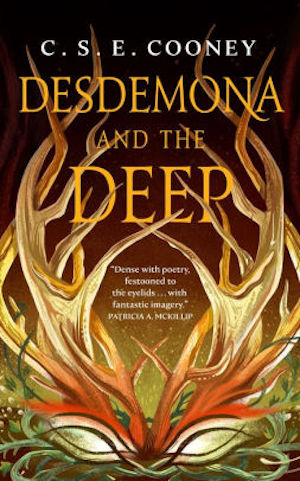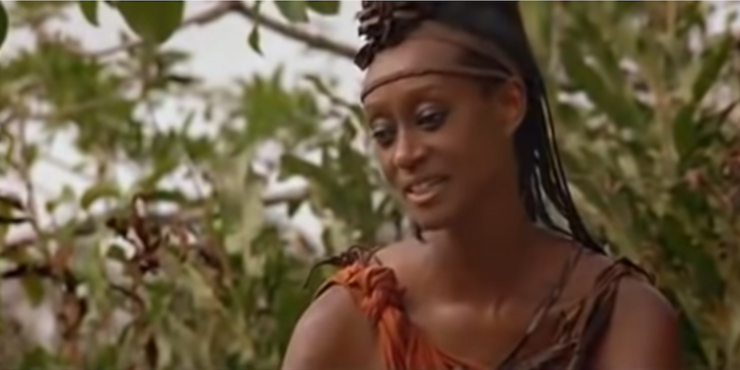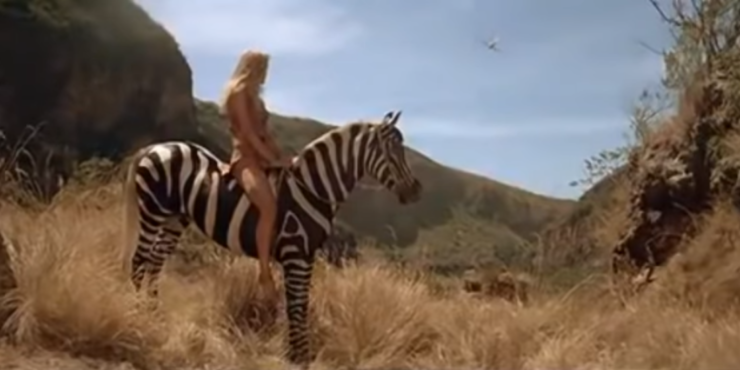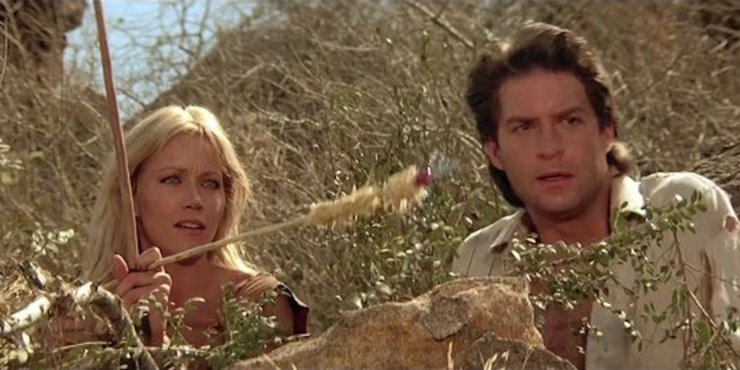Sheena, Queen of the Jungle was the first comic book to have a female lead, preceding Wonder Woman‘s 1941 debut by a good four years.
A creation of the Eisner/Iger Studio that produced tons of comic books in the 1930s, Sheena debuted in Wags magazine in 1937, and soon thereafter appeared regularly in both Jumbo Comics and her own title. Inspired by the works of W.H. Hudson (whose Rima, the “jungle girl” heroine of his 1904 novel Green Mansions, was an obvious inspiration for Sheena), Edgar Rice Burroughs, Rudyard Kipling, and H. Rider Haggard, Sheena would inspire many jungle queen-type characters.
Twice, Sheena has been adapted into television, in the 1950s starring Irish McCalla and in the 2000s starring Gena Lee Nolin, and between those, there was a movie in 1984.
Sheena’s storyline is a familiar one to anyone who’s read or watched a Tarzan story, or read or seen any of Mowgli’s adventures, or read Green Mansions: an orphan raised in the jungle of an “exotic” (read: non-European) setting and communing with the animals there to become partly “savage.” They usually wind up fighting the oppressors of the brown-skinned people in the exotic locale, and being their greatest hero, thus fulfilling white savior and white supremacist stereotypes.
Still, it was an archetype of the time, and Jerry Iger and Will Eisner were simply cashing in on a trend, with the twist of the orphan in their case being a woman. Interestingly, later revivals of Sheena moved her from Africa to South America, probably because they thought that was better (it isn’t), or maybe because Africa as the “dark continent” was more played out than South America as a similar dangerous jungle. Either way, Sheena paved the way for many other similar characters, including Marvel’s Shanna the She-Devil. In addition, Ike Turner credited Sheena Queen of the Jungle as the inspiration for the stage persona of his wife—her stage name of Tina was apparently chosen because it rhymes with Sheena.
Buy the Book


Desdemona and the Deep
Paul Aratow, a documentary filmmaker, started the process of a Sheena film back in 1974, with Raquel Welch initially attached as the star. In a 1980 interview, Aratow said that he wanted to make a movie with a star that his six-year-old daughter could look up to. “Girls today,” he said forty years ago, “need superheroes.” Nothing changes….
The movie bounced from studio to studio, finally winding up with Columbia following the success of 1982’s Tarzan the Ape Man, which focused on Jane, played by Bo Derek. Welch was long gone from the project, and Derek was considered also, before they settled on Tanya Roberts. At that point, Roberts was best known as the last-ditch Angel on the final season of Charlie’s Angels, replacing Shelley Hack (who herself replaced Kate Jackson), and also as the female lead in The Beastmaster, which probably served as a good audition for playing Sheena. John Guillerman, one of the biggest action movie directors of the mid-to-late 20th century, whose past credits included Tarzan Goes to India, The Towering Inferno, and the 1976 King Kong remake, was tapped to direct, and he brought in Lorenzo Semple Jr., of Batman ’66 and Flash Gordon ’80 fame, with whom Guillerman had worked on King Kong, to do a final rewrite of the script.
The rest of the cast included Ted Wass (who will always be Danny Dallas on Soap to me) as Vic Casey, Donovan Scott as Fletch Agronsky, Princess Elizabeth of Toro (yes, really) as the shaman, France Zobda (in one of her first roles—she’s credited as “introducing”) as Zanda, Trevor Thomas as Otwani, John Forgeham as Jorgensen, and Kirsty Lindsay and Kathryn Gant as younger versions of Sheena.
Filming took place entirely in Africa, and was beset by paperwork and animal training issues. The movie itself was a critical and box-office bomb, nominated for five Golden Raspberry Awards that year. (Amusingly, it didn’t “win” any Razzies, as the awards were pretty well swept by Bolero, which starred Derek, who starred in that rather than this. Cha cha cha.)
“Keep the fear inside you; I have enough of my own”
Sheena
Written by David Newman and Leslie Stevens and Lorenzo Semple Jr.
Directed by John Guilllermin
Produced by Paul Aratow
Original release date: August 17, 1984

Two white archaeologists are at the Gudjara Mountain in Tigora, traveling with their baby daughter Janet. Home of the Zambuli tribe, the mountain’s earth is reputed to have healing powers. The archaeologists see this healing with their own eyes.
They head over to check out a cave, leaving Janet asleep in the tent. But Janet wakes up and sneaks out of the tent, wandering around in only a diaper. She calls out for Mommy and Daddy, and her mother hears her, and shouts “Janet!” at the top of her lungs, which immediately starts a cave-in that kills them both.
The Zambuli shaman, after posthumously awarding Janet’s parents a Darwin Award, takes Janet in, renaming her Sheena, and claiming that she’s part of a prophecy that a golden child will protect them.
Sheena grows up learning the ways of the jungle, and how to communicate with the local fauna—sometimes verbally, sometimes telepathically, the latter accomplished by Sheena putting her hand to her head and looking like she has both a headache and really bad constipation.
The king of Tigora is engaged to be married to Countess Zanda. The king’s brother, Prince Otwani, has found fame and fortune as a place-kicker for an American football team. He has returned home to Tigora and is secretly working with a scientist who has confirmed that there is titanium in the Gudjara Mountain. Otwani aspires to take his brother’s throne and then strip-mine the mountain—which the king won’t do out of respect for the Zambuli. To keep his secrets, Otwani kills the scientist.
The shaman receives a vision of the king’s death, and journeys to Azan, the capital city, to warn him. She’s never been to the city before, and she’s apprehensive—as is Sheena.
Otwani’s return home is accompanied by television journalist Vic Casey and his camera operator Fletch Agronsky. The king plans a huge state dinner in honor of his brother’s return home. He also informs Otwani that he’s heard rumblings of a revolutionary force gathering in a hotel. Otwani says he’ll look into it.
We then find out that Otwani and Zanda are having a secret affair, and they’re the ones behind the revolution. In addition, the police found the shaman walking into Azan and immediately arrested her. Otwani thinks this is a bad idea, but Zanda points out that they can kill the king with a Zambuli arrow and frame the shaman for it.
At the state dinner, Otwani and Zanda enact their plan, and the king is shot by a Zambuli arrow shot from a crossbow in a nearby tree. Fletch gets it all on camera. The shaman is brought forth by the police, accused of killing the king. Strangely, even though she’s innocent, the shaman says nothing in her own defense.
Sensing something is amiss with her surrogate mother, Sheena hops on Marika, her zebra (really a horse painted black and white), and brings along an elephant and two chimps to Azan. They break the shaman out of prison, where she’s been beaten badly.
Casey and Fletch discover that, while Fletch was clearing jammed film during the dinner, he got a shot of the hidden crossbow that killed the king. Realizing that the shaman couldn’t have done it—the Zambuli never developed the crossbow, for one thing—they head to the prison, just in time to watch Sheena’s animal-aided jailbreak. Casey even cold-cocks one of the guards before he can fire his rifle at Sheena.
Sheena rides off with the shaman. Casey and Fletch follow as best they can in their Range Rover, until they’re stopped by a whole bunch of lions. Sheena herself arrives and wants to know why they’re following her. Casey tries to explain that he knows the shaman is innocent, and he wants to record her story—Sheena is shocked by his tape recorder and the notion that words can be saved and replayed like that.
Otwani, Zanda, and their mercenaries, led by Colonel Jorgensen, are heading toward Gudjara, ostensibly to track down the shaman, but truly to wipe out the Zambuli and clear the way for their mining.
Casey sends Fletch back with the Range Rover to make sure the incriminating film is safe. Sheena promises to take Casey to see the shaman, even though the shaman is dead, dying in Sheena’s arms and buried in a grave dug by the elephant.
Sheena and Casey barely stay ahead of the soldiers, using Sheena’s knowledge of the area and ability to leap about on trees and ride her horse-painted-to-look-like-a-zebra. They head to one of the outlying Zambuli villages, but they arrive just as Jorgensen and his men level it, killing everyone there.
In revenge, Sheena uses Casey’s lighter, sap from a tree, and an arrow to set the caravan’s gas truck on fire—but they also have a helicopter, the blades of which are used to put out the fire. Along the way, Casey figures out that the shaman is dead (Sheena talks in her sleep), but sticks around because he’s fallen in love with her. Eventually, they wind up sleeping together, as Sheena knows this might be her last night alive.
Sheena and Casey are captured. Zanda wants Sheena killed, but Otwani finds her attractive, and sends her off the helicopter with Zanda. However, Zanda wants no part of Sheena, and sees the way Otwani looks at her, and so brings her to the waterfalls near the main Zambuli settlement of Zakura so she can plummet to her death in front of her people.
Casey bargains with Otwani to spare the Zambuli in exchange for the film evidence. Otwani sends Casey off with two of Jorgensen’s soldiers.
Under the guise of a headache from the helicopter blades, Sheena summons a mess of birds to fly into the chopper and claw and bite at the pilot and Zanda. The countess falls out of the copter into the falls—the very fate she intended for Sheena—and the chopper crashes after Sheena jumps out into a tree.
Sheena then organizes the Zambuli to ambush Otwani, Jorgensen, and their soldiers, aided by various animals, including the elephant, the chimps, some lions, and a particularly vicious rhinoceros. Somehow, they catch the soldiers off-guard despite all wearing bright red that stands out amidst the flora like a sore thumb. The chief of the Zambuli kills Jorgensen personally in revenge for the massacred village (Jorgensen’s protest that he was just following orders falling on disinterested ears).
Otwani escapes into the desert in a jeep. However, Casey managed to very unconvincingly overpower his escorts and take the jeep back. Otwani is now harassed on two sides, one by Casey in his stolen jeep, the other by Sheena on her horse-painted-to-look-like-a-zebra. Otwani shoots Sheena, wounding her shoulder, but Sheena shoots an arrow that kills Otwani. However, Sheena’s about to be hit by his now-driverless jeep, until Casey rams his jeep into it, destroying them both. Casey is badly burned, but Sheena takes him to the healing Earth to cure him.
Casey realizes that he needs to keep the secret of the healing Earth from the rest of the world to protect the Zambuli. Reluctantly, he leaves Sheena behind where she’ll be safe, though he does have a recording of her saying “I love you.”
“What was she doing in the jungle, her junior year abroad?”

This is a spectacularly offensive film on so many levels. The dark-skinned characters are mostly either portrayed as “primitives,” naïve and victims, or as devious and nasty, with the sole exception of Casey and Fletch’s local assistant, who has very little screen time. The white characters are all noble and upright and true, with the sole exception of Jorgensen, who speaks with a German accent, so we know he’s evil…
It all starts so hideously when Sheena’s parents die because her mother is too stupid to know better than to shout in a geologically unstable cave, and it never gets any better. Tanya Roberts has a permanent wide-eyed expression of befuddlement on her face which only changes when she does the goofy-ass summoning-of-animals telepathy trick. At no point is she ever convincing as the chosen one, no matter how many times the shaman—who is the textbook definition of the Magical Negro trope—says she is. Sheena’s “inspirational” speech to the Zambuli is laughably bad, and the chemistry between her and Ted Wass’s Casey is pretty much nonexistent. This is not aided by Wass being almost as bad as Roberts with a completely nowhere personality. At no point does Wass convince me that he’s in love with Sheena, and their entire relationship is an artifact of a script that the actors are seemingly incapable of living up to.
The plot is depressingly paint-by-numbers, and watching it unfold is as exciting as watching that paint dry. The triangle among the king, prince, and countess is a tired trope that the movie does nothing to make interesting, as all three characters are formless, gormless, and boring.
Sheena, both in comics and screen form, embodies the worst sort of white savior stereotype that was all the rage in the late 19th and early 20th centuries, and it really hasn’t aged well. This movie in particular has nothing to mitigate that, as it’s not particularly fun, it’s not particularly engaging, the plot is stultifying, the acting is miserable, and it’s just awful. One wishes to see the alternate timeline where Raquel Welch played the title role, as she would have at least brought some verve and life to the role. All Roberts can do is be wide-eyed and ride a horse painted to look like a zebra well.
Next week, we see if the third time’s the charm, as we look at yet another attempt at Marvel’s first family, 2015’s Fantastic Four.
Keith R.A. DeCandido will be one of the author guests at Dragon Con over Labor Day weekend in Atlanta. His full—and, frankly, insane—schedule, which includes several autographings, a reading, a practical self-defense workshop, and panels on the American Sci-Fi Classics, Horror, Military Sci-Fi Media, Star Trek, Urban Fantasy, Writers, and Young Adult Literature Tracks, can be found here.










